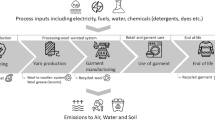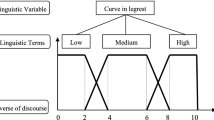Abstract
Material selection is one of the main phases of product design process that has great impact on the manufacturing of sustainable products. One of the best approaches of material selection for sustainable products is life cycle engineering (LCE). But LCE is a costly and cumbersome task and it is not economic to perform this task for a large number of proposed materials in order to choose the most suitable one for a sustainable product. Instead, it is more reasonable to make a preliminary filtering on the proposed materials and obtain a shorter list of candidate materials and then perform LCE on alternatives which are obtained from preliminary filtering. Since environmental friendliness of materials is a critical sustainability issue, so it is a good criterion for preliminary filtering of alternatives. In this paper, a new methodology is proposed to support preliminary filtering of alternatives from environmental viewpoint. The methodology uses the knowledge of experts in the field of eco-design. The knowledge is translated to decision making rules and a decision tree is developed to guide the choice. In order to use the capabilities of frame-based systems, an object-oriented approach for representation of knowledge is also proposed. Moreover, a prototype hybrid expert system based on the proposed methodology called material selection expert system for sustainable product design is developed to support the task of preliminary filtering. Finally, a case study from tire manufacturing industries is presented to show the validity of the proposed system. The results show that the system can determine the appropriate candidate materials and hence improve the possibility of manufacturing of more sustainable products. Eliminating alternatives that do not have the necessary conditions for sustainable product leads to a large saving in time and cost of the LCE evaluation process
Similar content being viewed by others
References
Azapagic A, Perdan S, Clift R (2004) Sustainable development in practice: case studies for engineers and scientists. Wiley, New York
Abraham MA (2006) Sustainability in science and engineering: defining principles. Elsevier, New York
Skerlos SJ, Morrow WR, Michalek JJ (2006) Sustainable design engineering and science: selected challenges and case studies. In: Abraham MA (ed) Sustainability in science and engineering: defining principles. Elsevier, New York
Jeswiet J (2007) Design for the environment. In: Kutz M (ed) Environmentally conscious manufacturing. Wiley, New York
Ljungberg LY (2007) Materials selection and design for development of sustainable products. Mater Des 28:466–479
Ashby M (1999) Materials selection in mechanical design. Butterworthe-Heinemann
Holloway L (1998) Materials selection for optimal environmental impact in mechanical design. Mater Des 19(4):133–143
Ermolaeva NS, Castro MBG, Kandachar PV (2004) Materials selection for an automotive structure by integrating structural optimization with environmental impact assessment. Mater Des 25:689–698
Giudice F, La Rosa G, Risitano A (2005) Materials selection in the life cycle design process: a method to integrate mechanical and environmental performances in optimal choice. Mater Des 26:9–20
Chan JWK, Tong TKL (2007) Multi-criteria material selections and end-of-life product strategy: grey relational analysis approach. Mater Des 28:1539–1546
Ribeiro I, Pecas P, Silva A, Henriques E (2008) Life cycle engineering methodology applied to material selection: a fender case study. J Cleaner Prod 16(17):1887–1899. doi:10.1016/j.jclepro.2008.01.002
Zhou C-C, Yin G-F, Hu X-B (2009) Multi-objective optimization of material selection for sustainable products: artificial neural networks and genetic algorithm approach. Mater Des 30–4:1209–1215. doi:10.1016/j.matdes.2008.06.006
Thurston DL, Lloyd SM, Wallace J (1994) Considering customer preferences for environmental protection in material selection. Mat Design 15(4):203–209
Lin, Feng (2006) A methodology for material selection in green design with toxic impact concern, PhD thesis, State University of New York at Buffalo, IE & System Dep
Lin F, Lin L (2003) A discussion of the state-of-art research on environmentally conscious material selection methodologies for the reduction of products toxic impact. J Sustain Prod Des 3:119–134
Weaver PM, Ashby MF, Burgess S, Shibaike N (1996) Selection of materials to reduce environmental impact: a case study on refrigerator insulation. Mater Des 17(1):11–17
Almeida CMVB, Rodrigues AJM, Bonilla SH (2010) Emergy as a tool for ecodesign: evaluating materials selection for beverage packages in Brazil. J Cleaner Prod 18:32–43. doi:10.1016/j.jclepro.2009.03.019
Bovea MD, Vidal R (2004) Materials selection for sustainable product design: a case study of wood based furniture eco-design. Mater Des 25:111–116
Abeysundara UGY, Sandhya B, Shabbir G (2009) A matrix in life cycle perspective for selecting sustainable materials for buildings in Sri Lanka. Build Environ 44:997–1004. doi:10.1016/j.buildenv.2008.07.005
Lacouture DC, Sefair JA, Flórez L, Medaglia AL (2009) Optimization model for the selection of materials using a LEED-based green building rating system in Colombia. Build Environ 44:1162–1170
Bovea MD, Gallardo A (2006) The influence of impact assessment methods on materials selection for eco-design. Mater Des 27:209–215
Shi Q, Xu Y (2009) The selection of green building materials using GA-BP hybrid algorithm. Int Con Artif Intell Comput Intell. doi:10.1109/AICI.2009.74
Chen RW, Navin-Chandra D, Prinz F (1994) A systematic methodology for material selecton with environmental consideration. Proceeding of the IEEE International Symposium on Electronics and the Environment
Fussler CR, Krummenacher B (1991) Ecobalances: a key to better environmental material choices in automobile design. Mater Des 12(3):123–128
Yuan CY, Dornfeld DA (2010) A schematic method for sustainable material selection of toxic chemicals in design and manufacturing. J Mech Des. doi:10.1115/1.4002199
Yuan CY, Dornfeld D (2009) Sustainable material selection of toxic chemicals in design and manufacturing from human health impact perspective, ASME Paper No. DETC 2009–87145
Yuan CY, Dornfeld DA (2009) Schematic characterization of human health impact of toxic chemicals for sustainable design and manufacturing. Proceedings of IEEE International Symposium on Sustainable Systems and Technology, Phoenix, AZ, May 18–20
Vezzoli C, Manzini E (2008) Design for environmental sustainability. Springer, New York
Pilani R, Narasimhan K, Maiti SK, Singh UP, Date PP (2000) A hybrid intelligent systems approach for die design in sheet metal forming. Int J Adv Manuf Technol 16:370–375
Zha XF (2005) A web-based advisory system for process and material selection in concurrent product design fora manufacturing environment. Int J Adv Manuf Technol 25(3–4):233–243. doi:10.1007/s00170-003-1838-0
Bamkin RJ, Piearcey BJ (1990) Knowledge-based material selection in design. Mater Des 11:25–29
Beiter K, Krizan S, Ishii K (1993) HyperQ/plastics: an intelligent design aid for plastic material selection. Adv Eng Softw 16(1):53–60
Sharma PK et al (1993) An expert system for aid in material selection process. In: Proceedings of the 1993 IEEE International Engineering Management Conference, 17–18 December, New Delhi, India. p.27–31
Bullinger HJ, Warschat J, Fischer D (1991) Knowledge-based system for material selection for design with new materials. Knowl Based Syst 4:95–102
Chen JL, Sun SH, Hwang WC (1993) An intelligent database system for composite material selection in structural design. Expert Syst Appl 6:159–168
Sapuan SM, Abdalla HS (1998) A prototype knowledge-based system for the material selection of polymeric-based composites for automotive components. Compos A 29:731–742
Kumar S, Singh R (2007) A short note on an intelligent system for selection of materials for progressive die components. J Mater Process Technol 182:456–461
Sapuan SM (2001) A knowledge-based system for materials selection in mechanical engineering design. Mater Des 22:687–895
Sapuan SM, Jacob MSD, Mustapha F, Ismail N (2002) A prototype knowledge-based system for material selection of ceramic matrix composites of automotive engine components. Mater Des 23:701–708
Amen R, Vomacka P (2001) Case-based reasoning as a tool for materials selection. Mater Des 22:353–358
Rahman S, Perera S, Odeyinka H, Bi Y (2008) A conceptual knowledge-based cost model for optimizing the selection of materials and technology for building design. In: Dainty A (ed) Procs 24th Annual ARCOM Conference, 2008. Association of Researchers in Construction Management, Cardiff, pp 217–225
Mohamed A, Celik T (1998) An integrated knowledge-based system for alternative design and materials selection and cost estimating. Expert Syst Appl 14:329–339
Tretheweya KR, Wooda RJK, Pugeta Y, Robergeb PR (1998) Development of a knowledge-based system formaterials management. Mater Des 19:39–56
Jahan A, Ismail MY, Sapuan SM, Mustapha F (2010) Material screening and choosing methods—a review. Mater Des 31:696–705. doi:10.1016/j.matdes.2009.08.013
Jeswiet JA (2003) Definition of life cycle engineering. In: Bley H (ed) Proceedings of the thirty-sixth CIRP International Seminar on Manufacturing Systems. Saarbru cken p. 17–20
Wanyama W, Ertas A, Zhang H-C, Ekwaro-Osire S (2003) Life-cycle engineering: issues, tools and research. Int J Computer Integr Manuf 16(4):307e16
Environmental Protection Agency (2001) Life cycle engineering guidelines. EPA Report 600/R-01/101
Schmidt W-P, Taylor A (2006) Ford of Europe’s product sustainability index. Organization for economic co-operation and development
Saur K, Fava JA, Spatari S (2000) Life cycle engineering case study automobile fender designs. Environ Prog 19(2):72e82
Banaitiene N, Banaitis A, Kaklauskas A, Zavadskas EK (2006) Evaluating the life cycle of a building: amultivariantand multiple criteria approach. Omega 36(3):429e41
Ebert C (2007) The impacts of software product management. J Syst Softw 80(6):850e61
Penoyer JA, Burnett G, Fawcett DJ, Liou S-Y (2000) Knowledge based product life cycle systems: principlesofintegration of KBE and C3P. Comput-Aided Des 32(5e6):311e20
Betz M, Schuckert M, Herrmann C (1998) Life cycle engineering as decision making support in the electronics industry. In: Proceedings of the custom integrated circuits conference. IEEE
Chiner M (1988) Planning of expert systems for materials selection. Mater Des 9:195–203
Ermolaeva NS, Kaveline KG, Spoormaker JL (2002) Materials selection combined with optimal structural design: concept and some results. Mater Des 23:459–470
Farag MM (2002) Quantitative methods of materials selection. In: Kutz M, editor. Handbook of materials selection
Mizuki C, Snadborn PA, Pitts G (1996) Design for environment—a survey of current practices and tools. In: IEEE International Symposium on Electronics and the Environment pp. 1–6
Navinchandra D (1991) Design for environmentability. Des Theory Methodol 31:119–124
Leonard L (1991) Design for the environment. Plastics design forum, May/June 25–32
Korpalski T (1996) The role of product steward in advancing design for environmental in Hewlett-Packard’s computer products organization. In: IEEE Int Symp on Electronics and the Environment pp. 37–41
Fiksel J, Wapman K (1994) How to design for environment and minimize life cycle cost. In: IEEE International Symposium on Electronics and the Environment, San Francisco, CA, May
Luttropp C, Lagerstedt J (2006) EcoDesign and the ten golden rules: generic advice for merging environmental aspects into product development. J Cleaner Prod 14:1396–1408
Billatos SB (2002) Design methodologies for the environment. In: Hundal MS (ed) Mechanical life cycle handbook: good environmental design and manufacturing. Marcel Dekker
Wimmer W, Zust R (2003) ECODESIGN Pilot: product investigation, learning and optimization tool for sustainable product development. Kluwer Academic Publishers
Fiksel J (1996) Design for the environment: creating eco-efficient products and processes. McGraw Hill, New York
Mackenzie D (1991) Green design: design for the environment. Laurence King, London
Giudice F, La Rosa G, Risitano A (2006) Product design for the environment: a life cycle approach. Taylor & Francis Group
IntelliCorp (2006) Kappa-PC user’s guide, Version 2.0. IntelliCorp, Inc, USA
Golabchi M (2008) A knowledge-based expert system for selection of appropriate structural system for large spans. Asian J Civ Eng Build Hous 9(2):179–191
Hilton CM, Meieran ES (1990) Use of expert systems in manufacturing, knowledge applications lab Intel Corporation Chandler, IEEE/CHMT '90 IEMT Symposium
Jayaraman V, Srivastava R (1996) Expert systems in production and operations management current applications and future prospects. Int J Op Prod Manag 16(12):27–44
Cornelius T (2002) Expert systems: the technology of knowledge management for the 21st century, six volume set. Academic, San Diego
Liao S-H (2005) Expert system methodologies and applications—a decade review from 1995 to 2004. Expert Syst Appl 28:93–103
Abou-Ali GM, Khamis M (2003) TIREDDX: an integrated intelligent defects diagnostic system for tire production and service. Expert Syst Appl 24(3):247–259
ChemRisk Inc (2008) State of knowledge report for tire material and tire wear particles. Prepared by ChemRisk Inc. Available from: www.wbcsd.org
Ashby MF (2009) Materials and the environment: eco-informed material choice. Elsevier, New York
Author information
Authors and Affiliations
Corresponding author
Rights and permissions
About this article
Cite this article
Zarandi, M.H.F., Mansour, S., Hosseinijou, S.A. et al. A material selection methodology and expert system for sustainable product design. Int J Adv Manuf Technol 57, 885–903 (2011). https://doi.org/10.1007/s00170-011-3362-y
Received:
Accepted:
Published:
Issue Date:
DOI: https://doi.org/10.1007/s00170-011-3362-y




